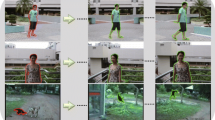Abstract
False-positive removal is a necessary step for robust video object segmentation because of the presence of visual noise introduced by unavoidable factors such as background movements, light changes, artifacts, etc. In this paper we present a set of generic visual cues that enable the discrimination between true positives and false positives detected by a video object segmentation approach. The devised object features encode real-world object properties, such as shape regularity, marked boundaries, color and texture uniformity and motion continuity and can be used in a post-processing layer to reject false positives.
A thorough performance evaluation of the employed features and classifiers is carried out in order to identify which visual cues/classifier allow for a better separability between true and false positives. The experimental results, obtained on three challenging datasets, showed that a post-processing layer exploiting the devised visual features is able a) to reduce the false alarm rate by about 10% to 20%, while keeping the number of true positives almost unaltered, and b) to generalize over different object classes and application domains.
Access this chapter
Tax calculation will be finalised at checkout
Purchases are for personal use only
Preview
Unable to display preview. Download preview PDF.
Similar content being viewed by others
References
Aha, D.W., Bankert, R.L.: A comparative evaluation of sequential feature selection algorithms, vol. 206, pp. 1–7. SpringerVerlag New York (1995)
Alexe, B., Deselaers, T., Ferrari, V.: Measuring the Objectness of Image Windows. IEEE Transactions on Pattern Analysis and Machine Intelligence, PP(c), 1–14 (2012)
Bai, X., Wang, J., Sapiro, G.: Dynamic color flow: a motion-adaptive color model for object segmentation in video. In: Daniilidis, K., Maragos, P., Paragios, N. (eds.) ECCV 2010, Part V. LNCS, vol. 6315, pp. 617–630. Springer, Heidelberg (2010)
Barnich, O., Van Droogenbroeck, M.: ViBe: a universal background subtraction algorithm for video sequences. IEEE transactions on image processing : a publication of the IEEE Signal Processing Society 20(6), 1709–24 (2011)
Bouguet, J.-Y.: Pyramidal Implementation of the Lucas-Kanade Feature Tracker Description of the algorithm (2000)
Brox, T., Malik, J.: Object segmentation by long term analysis of point trajectories. In: Daniilidis, K., Maragos, P., Paragios, N. (eds.) ECCV 2010, Part V. LNCS, vol. 6315, pp. 282–295. Springer, Heidelberg (2010)
Brutzer, S., Hoferlin, B., Heidemann, G.: Evaluation of background subtraction techniques for video surveillance. In: 2011 IEEE Conference on Computer Vision and Pattern Recognition (CVPR), pp. 1937–1944, June 2011
Cheng, C., Koschan, A., Chen, C.-H., Page, D.L., Abidi, M.: Outdoor scene image segmentation based on background recognition and perceptual organization. IEEE Transactions on Image Processing 21(3), 1007–1019 (2012)
Cortes, C., Vapnik, V.: Support-vector networks. Machine Learning 20(3), 273–297 (1995)
Erdem, C.E., Sankur, B., Tekalp, A.M.: Performance measures for video object segmentation and tracking. IEEE Transactions on Image Processing 13(7), 937–951 (2004)
Felzenszwalb, P., Huttenlocher, D.: Efficient graph-based image segmentation. International Journal of Computer Vision 59(2), 167–181 (2004)
Krzanowski, W.J.: Principles of Multivariate Analysis: A User’s Perspective. Oxford University Press, New York (1988)
Lee, Y. J., Kim, J., Grauman, K.: Key-segments for video object segmentation. In: Proceedings of the 2011 International Conference on Computer Vision, ICCV 2011, pp. 1995–2002 (2011)
Li, L., Huang, W., Gu, I.Y.H., Tian, Q.: Foreground object detection from videos containing complex background. In: Proceedings of the Eleventh ACM International Conference on Multimedia MULTIMEDIA 2003, vol. 3, p. 2 (2003)
Lim, J., Han, B.: Generalized background subtraction using superpixels with label integrated motion estimation. In: Fleet, D., Pajdla, T., Schiele, B., Tuytelaars, T. (eds.) ECCV 2014, Part V. LNCS, vol. 8693, pp. 173–187. Springer, Heidelberg (2014)
Liu, Z., Jacobs, D.W., Basri, R.: The role of convexity in perceptual completion: beyond good continuation. Vision Research 39(25), 4244–4257 (1999)
Ochs, P., Malik, J., Brox, T.: Segmentation of moving objects by long term video analysis. IEEE Transactions on Pattern Analysis and Machine Intelligence 36(6), 1187–1200 (2014)
Papazoglou, A., Ferrari, V.: Fast object segmentation in unconstrained video. In: 2013 IEEE International Conference on Computer Vision, pp. 1777–1784, December 2013
Ochs, P., Brox, T.: Object segmentation in video: a hierarchical variational approach for turning point trajectories into dense regions. In: IEEE International Conference on Computer Vision (ICCV) (2011)
Sheikh, Y., Shah, M.: Bayesian object detection in dynamic scenes. In: 2005 IEEE Computer Society Conference on Computer Vision and Pattern Recognition CVPR 2005, vol. 1, pp. 74–79 (2005)
Spampinato, C., Palazzo, S.: Enhancing object detection performance by integrating motion objectness and perceptual organization. In: 2012 21st International Conference on Pattern Recognition (ICPR), pp. 3640–3643, November 2012
Stauffer, C., Grimson, W.: Adaptive background mixture models for real-time tracking. In: Proceedings of 1999 IEEE Computer Society Conference on Computer Vision and Pattern Recognition (Cat. No PR00149), pp. 246–252 (1999)
Stauffer, C., Grimson, W.E.L.: Adaptive background mixture models for real-time tracking. In: IEEE Computer Society Conference on Computer Vision and Pattern Recognition, vol. 2, pp. 246–252 (1999)
Stauffer, C., Grimson, W.E.L.: Learning patterns of activity using real-time tracking (2000)
Zhang, D., Javed, O., Shah, M.: Video object segmentation through spatially accurate and temporally dense extraction of primary object regions. In: 2013 IEEE Conference on Computer Vision and Pattern Recognition, pp. 628–635 (2013)
Author information
Authors and Affiliations
Corresponding author
Editor information
Editors and Affiliations
Rights and permissions
Copyright information
© 2015 Springer International Publishing Switzerland
About this paper
Cite this paper
Giordano, D., Kavasidis, I., Palazzo, S., Spampinato, C. (2015). Rejecting False Positives in Video Object Segmentation. In: Azzopardi, G., Petkov, N. (eds) Computer Analysis of Images and Patterns. CAIP 2015. Lecture Notes in Computer Science(), vol 9256. Springer, Cham. https://doi.org/10.1007/978-3-319-23192-1_9
Download citation
DOI: https://doi.org/10.1007/978-3-319-23192-1_9
Published:
Publisher Name: Springer, Cham
Print ISBN: 978-3-319-23191-4
Online ISBN: 978-3-319-23192-1
eBook Packages: Computer ScienceComputer Science (R0)




